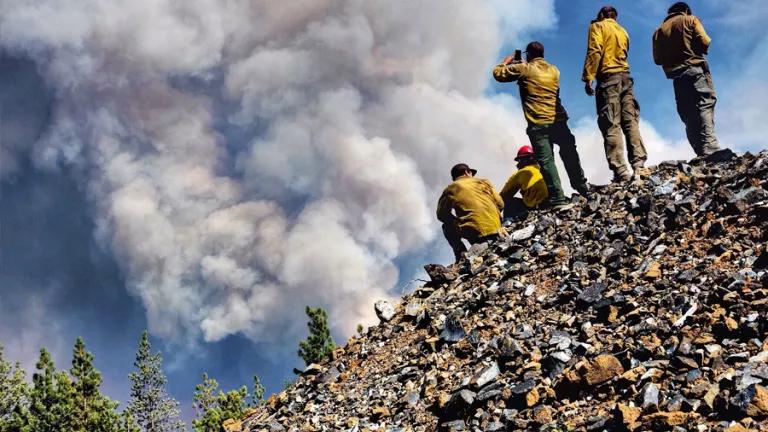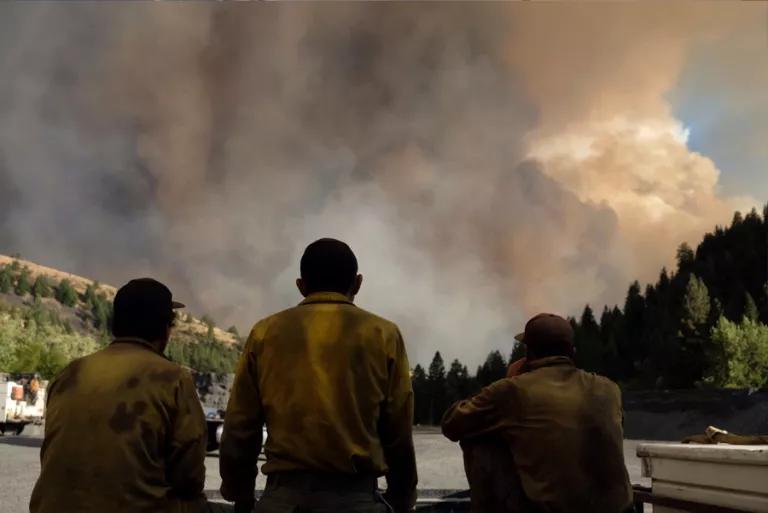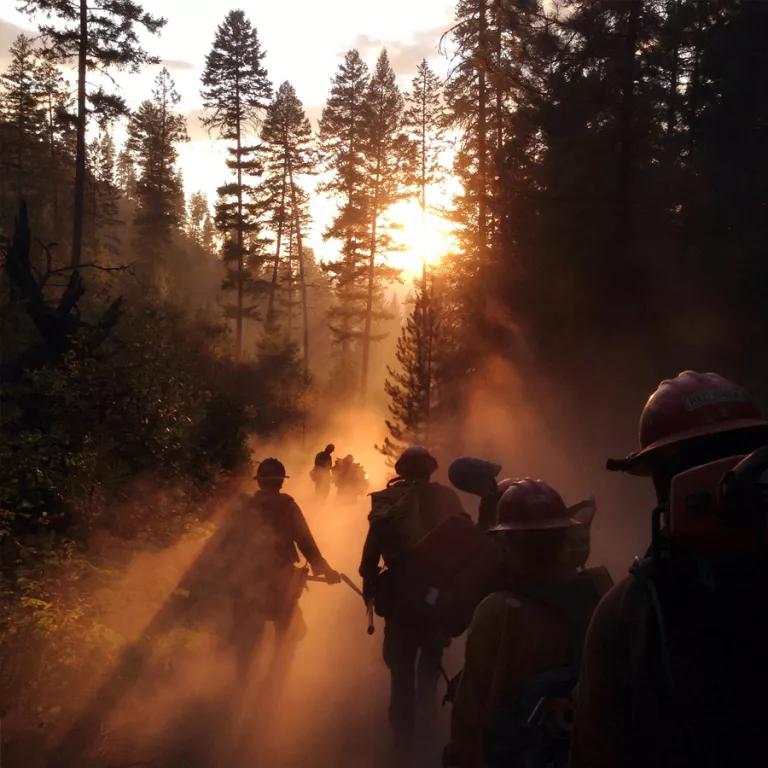
Trying to pin down Avi Farber for an interview is no easy task. He had arranged to call me at around 11 at night, after battling the Canyon Creek Complex fire in eastern Oregon—a day that started at 5:30 a.m., just like every other day Farber’s on duty. At 7:20 p.m., I got a text message saying that the fire “blew up again today,” and he’d likely be working through the night. Such is the life of a member of an elite hotshot crew, the professional wildland firefighters who have been racing to contain blazes this year, one of the worst wildfire seasons on record.
Farber, a first-year hotshot (but second-year wildfire fighter), says he’s “definitely still a rookie,” but hotter, drier, and longer fire seasons are giving him plenty of chances to bulk up on his experience—which he has been chronicling with the camera he has strapped to his side. When he calls me at 12:30 one afternoon with a few free minutes, I bombard him with questions about fires and photography, and how and why he’s combined the two.
Where are you right now?
Avi Farber: I’m standing on a ridgetop, on the border of a wilderness area, about a 20-minute drive up a dirt road. If a fire started, we’d be pretty safe here. A plane is flying in front of me, painting a line of red slurry [fire retardant] across the ridgeline to the south so the fire won’t burn down toward town, toward John Day. They use different-sized planes. Yesterday it was a DC-10; they always look like they’re about to fall out of the sky—they’re so huge and going so slow.

Is there any such thing as a typical day?
AF: [Laughs] There is no such thing. We work 14 days on, then two days off, but if things are really crazy, they’ll tack on a seven-day extension before we get the two rest days. From the time we wake up, we’re moving quickly—we get five minutes to load up, eat breakfast, get in the buggy [customized trucks that serve as the hotshots’ mobile field base], and drive out to the daily briefing.
Hold on—where are you sleeping?
AF: Right now we’re sleeping in the skate park in John Bay. It’s the nicest place we’ve slept in a long time because it’s really flat. We don’t even pitch tents because it takes too much time. We just put down tarps and crash on top of them.
Once we’re briefed on what we’re doing that day, sometimes we have to hike into an area, which can mean many hours of carrying chainsaws, shovels, drip torches—all our gear. Sometimes they fly us in with helicopters, which is great.
When we get out there, we’ll create a fuel break, digging a trench and then cutting out trees near that line, so when the fire gets there, there’s nothing to burn. Or we burn our own fire—we have quite a bit of control on intensity, using drip torches [hand-carried tools that drop flaming liquid onto grasses or other fuels to be burned]. The fires we set eat up fuel, so when the big fire arrives, there’s nothing to burn. We’re always really close to the fire, and they keep us in until the last minute.
Is that what you were doing yesterday?
AF: Yes, we were working on containment lines, but then they moved us out to the head of the fire, the area that’s progressing. It’s pretty fierce when the fire is blowing up; it’s unpredictable. They transferred us to a staging area on the highway, and we were sitting in our buggies, getting ready to do structure protection—building containment lines to save houses. Everyone was being evacuated, and there were these people passing by, their faces ashen. It was the first time I’d ever seen people leaving their homes.

You have to tell me the story behind the photograph of the fawn.
AF: We were doing a management fire in Arizona, with everyone walking in a line, spaced out, carrying drip torches and throwing out flame so that it all comes together, burning one large area. One guy threw fire right next to these fawns, maybe a couple of weeks old, which nobody noticed. They spooked, and that’s when the guy saw it, so we picked them up and carried them out of the fire area.

We see wildlife, or signs of wildlife, pretty frequently. We’re often in really remote places, especially when we hike in. Two weeks ago, we came across bear tracks. And we see a lot of deer. We also find a lot of deer and elk antlers, and I’ve collected some of those.
Do you have a favorite photo?
AF: There’s one of the crew walking, everyone carrying equipment. The evening light is golden and feels like it's pouring in.
This season I've been shooting with a Fuji X-M1, a small digital camera with a fixed lens, so it doesn’t have any zoom. I like this because it makes me move and I end up finding unexpected angles. The pictures are really crisp and it does a great job of catching the natural filters created when the sun is screened out by the smoke.

How do you find time to take photos?
AF: It’s kind of a challenge because first and foremost I’m a wildland firefighter, so I have to do my job, and that entails keeping everything tight. Everything is about being efficient, and carrying a camera can slow that down. So I’ve developed my own system. I have a case on my side, and I take photos within probably 15 seconds. Sometimes, when the fire is blowing up, I have a few minutes because we’re waiting.
I didn’t come into the season thinking I’m going to take a bunch of photos of these guys. I’m a creative person, and it’s an outlet. And we happen to be in beautiful places with incredible light, so I can’t help but take photos. Not many people have this inside perspective. I don’t want anything to be choreographed; I want to capture the person and situation as they are. A lot of fire photos are so sensational that it takes truth and rawness out of them. I strive to make viewers feel like they’re here.

Go to avifarber.com to see more of Avi's work.
This article was originally published on onEarth, which is no longer in publication. onEarth was founded in 1979 as the Amicus Journal, an independent magazine of thought and opinion on the environment. All opinions expressed are those of the authors and do not necessarily reflect the policies or positions of NRDC. This article is available for online republication by news media outlets or nonprofits under these conditions: The writer(s) must be credited with a byline; you must note prominently that the article was originally published by NRDC.org and link to the original; the article cannot be edited (beyond simple things such grammar); you can’t resell the article in any form or grant republishing rights to other outlets; you can’t republish our material wholesale or automatically—you need to select articles individually; you can’t republish the photos or graphics on our site without specific permission; you should drop us a note to let us know when you’ve used one of our articles.

What Is the Air Quality Index?
How to Make an Effective Public Comment
How to Become a Community Scientist